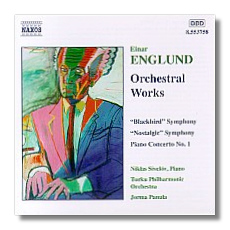
The Internet's Premier Classical Music Source
Related Links
- Latest Reviews
- More Reviews
-
By Composer
-
Collections
DVD & Blu-ray
Books
Concert Reviews
Articles/Interviews
Software
Audio
Search Amazon
Recommended Links
Site News
 CD Review
CD Review
Einar Englund

Symphonies
- Symphony #2 "The Blackbird"
- Symphony #4 "Nostalgic"
- Piano Concerto #1
Niklas Sivelöv, piano
Turku Philharmonic Orchestra/Jorma Panula
Naxos 8.553758 DDD 76:09
Shostakovich anyone? I couldn't help but think of his music as I listened to at least two of the three works on this CD by the late Finnish composer Einar Englund (1916-99). The 1948 Second Symphony has Shostakovich's fingerprints all over it. When a work is so obviously derivative, it usually means it isn't worthwhile. In this case, however, the music is gripping, full of color, and fascinating in its likenesses to the symphonies of Shostakovich. The first movement recalls the slightly lighter side of his music, though even in this mostly lively and colorfully scored movement, there are some dark moments. In the tense Andante that follows Englund displays this influence to a slightly less noticeable degree, though the haunting string sonorities of Shostakovich, as heard in the Passacaglia of his Eighth Symphony, appear near the end. The finale may be the best movement, with its mixture of bombast and terror, of desperation and cruel humor. All in all, this symphony must be ranked a fine work, worthy of far greater attention. Many symphonies by front-rank composers aren't this good.
By 1976, the year after Shostakovich's death and five years after that of Stravinsky, Englund, Ralf Hermans' album notes tell us, was inspired to write a work "to the memory of a great composer." Once again it is Shostakovich whose voice dominates here, with not an echo of Stravinsky anywhere to be heard. In fact, the brooding string sonorities of so many of the Soviet composer's slow movements permeate the first movement Prélude. For that matter, the whole work breathes not only the style but the often morbid and cynical emotions of Shostakovich. This composition may surpass the Second Symphony for sheer depth, but, forced to pick between the two, I don't know if I'd choose the greater expressive range of the earlier work or select this dark homage, which often reminded me of an orchestration of a lost late Shostakovich quartet.
The 1955 Piano Concerto is a slightly different matter. While echoes of Shostakovich may be present, other influences present themselves more prominently and most intriguingly – Bartók, especially in the first movement, and Prokofieff (I half-expected the otherwise somewhat bluesy second movement Larghissimo's descending chords, beginning at 1:25, to break right into the middle section of Prokofieff's Sixth Sonata's finale). Once again, it's the finale, colorful and featuring brilliant writing for both the piano and orchestra, that may offer the most attractive music. In the end, this concerto may not quite be on the level of the two symphonies, but it's still a worthwhile piece.
Swedish Pianist Niklas Sivelöv turns in a fine performance in the concerto and gets splendid support from Panula and the Turku players. The latter forces are also most compelling in the symphonies, imparting an authenticity and idiomatic grasp that would be hard to surpass. Naxos' sound is excellent and the notes are informative. As far as I'm concerned, despite the obvious influences in his music, Englund is a composer deserving of far great notice. This disc is certainly worth its budget price. At full price, it would even be a bargain.
Copyright © 2000, Robert Cummings


















